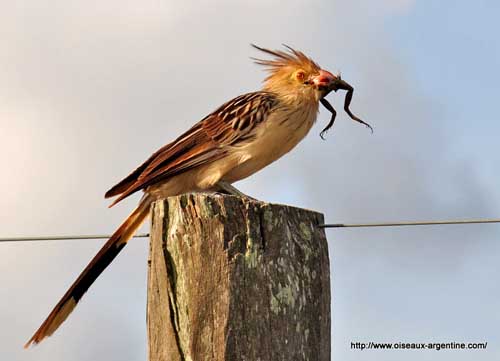
Photographers :
Didier Buysse
Vision d’Oiseaux
Marc Chrétien
MURINUS
Alfredo Colón
Puerto Rico Wildlife
Jean Michel Fenerole
Photos d’Oiseaux du monde
Patrick Ingremeau
TAMANDUA
Steve Garvie
RAINBIRDER Photo galleries
Philippe et Aline Wolfer
GALERIE
Text by Nicole Bouglouan
Sources :
HANDBOOK OF THE BIRDS OF THE WORLD vol 4 by Josep del Hoyo-Andrew Elliott-Jordi Sargatal - Lynx Edicions - ISBN: 8487334229
L’ENCYCLOPEDIE MONDIALE DES OISEAUX - Dr Christopher M. Perrins - BORDAS - ISBN: 2040185607
BirdLife International (BirdLife International)
CREAGUS@Monterey Bay (Don Roberson)
Wikipedia, the free encyclopaedia
CUCULIDAE FAMILY
Subfamily Crotophaginae
The subfamily Crotophaginae is the smallest with only two genera and four species.
The genus Crotophaga includes the three anis, and the genus Guira has only one species, the Guira Cuckoo.
All are nesting, group-living cuckoos. They perform co-operative breeding and are often seen in small groups.
The three anis have black plumage overall, but the Greater Ani (Crotophaga major) is the largest with a length of 46 cm. It has glossy blue-black plumage and bronze-green feather edges. It has white eyes. The bill shows a conspicuous arched ridge at the upper mandible’s base.

Crotophaga major
The Smooth-billed Ani (Crotophaga ani) and the Groove-billed Ani (Crotophaga sulcirostris) are very similar with black glossy plumage and dark eyes. However, we can see different bill pattern. The Smooth-billed Ani has high-arched, laterally compressed bill and curving down, whereas the Groove-billed Ani has less arched laterally compressed bill. The upper ridge is continuous with crown, and there are grooves on the upper mandible.

Crotophaga ani

Groove-billed Ani
Crotophaga sulcirostris
The Guira Cuckoo (Guira guira) is very different with combination of black, white and pale rufous plumage and shaggy-looking above with orange-rufous crest.

Guira guira
The Greater Ani and the Smooth-billed Ani from South America, frequent forested and wooded areas along rivers and occur generally near water. They are usually found in thick vegetation, from lowlands to 800/1200 metres of elevation, but much higher in Colombia and Bolivia, up to 2600 metres.
The Groove-billed Ani prefers drier shrubby areas, thickets, pastures, marshes, cleared and disturbed areas from tropical evergreen forest to tropical scrub. It is visible from sea-level up to 2300 metres, and occurs from Texas and Mexico, through Central America, to the coasts of South America, from Guyana to N Chile.
The Guira Cuckoo occurs in drier habitats such as second growth scrub, savannah with trees and scrubs, pampas, pastures and coastal dunes. It is found in E and S Brazil, W to Bolivia and Paraguay, S to Uruguay and N and E Argentina.
They feed on large insects of various species, caterpillars, spiders, small lizards, frogs, nestling birds and eggs, and also take fruit, berries and euphorbia seeds.

Groove-billed Ani
Crotophaga sulcirostris

Guira guira
They feed in flocks or small groups by walking on the ground or on the branches. They often follow cattle and other animals for flushing insects. They may pursue insects in flight, and they also follow the army ants.

Crotophaga ani

Guira guira
The Smooth-billed Ani climbs through the vegetation and uses its bill to separate the foliage when foraging.

Crotophaga ani
These birds fly very well with gliding, direct flight.

Guira guira
They are noisy birds because living in groups. They utter grows, croaks, hisses, mews, clucks, but also whistles, chatters and some guttural calls.
SOME SOUNDS BY XENO-CANTO
Smooth-billed Ani - Xeno-Canto
Groove-billed Ani - Xeno-Canto
These species are co-operative breeding. They live in groups and the nest is used by more than one female. In Crotophaga, they nest in loose colonies, and the territory is defended by the groups against the other groups.
The adults are socially monogamous, and each female is attended by her mate. They lay in the same bulky nest of sticks and green leaves, placed in branches of trees.

Groove-billed Ani
Crotophaga sulcirostris
The clutch varies from 6 to 18/20 eggs produced by several females. The incubation lasts 13-15 days, shared by both sexes. The male often feeds the female while she incubates. The young fledge 10-11 days after hatching.

Crotophaga ani
The Guira Cuckoos breed together and have communal nest, but competition and conflicts occur between breeding adults. The females lay in the same nest, but each female is able to recognize her own eggs and she cares them. Several eggs are lost, removed or dropped by adults, probably during the laying or the incubation.
In the same way, chicks are sometimes removed by adults, and the young birds may kill the nestlings.

Guira guira
The nest is a large open platform of sticks high in thorny tree. The incubation lasts 10-15 days and the young fledge two weeks later or sooner if disturbed.
The Guira Cuckoo may sometimes lay in other nests, including of anis, and they may incubate together.
The three anis are resident in their range. They perform some local movements and post-breeding dispersions.
The Guira Cuckoo is mainly resident.
All are generally common throughout their wide range.
These species are not currently threatened.

Guira guira

Crotophaga ani

Groove-billed Ani
Crotophaga sulcirostris

Crotophaga major